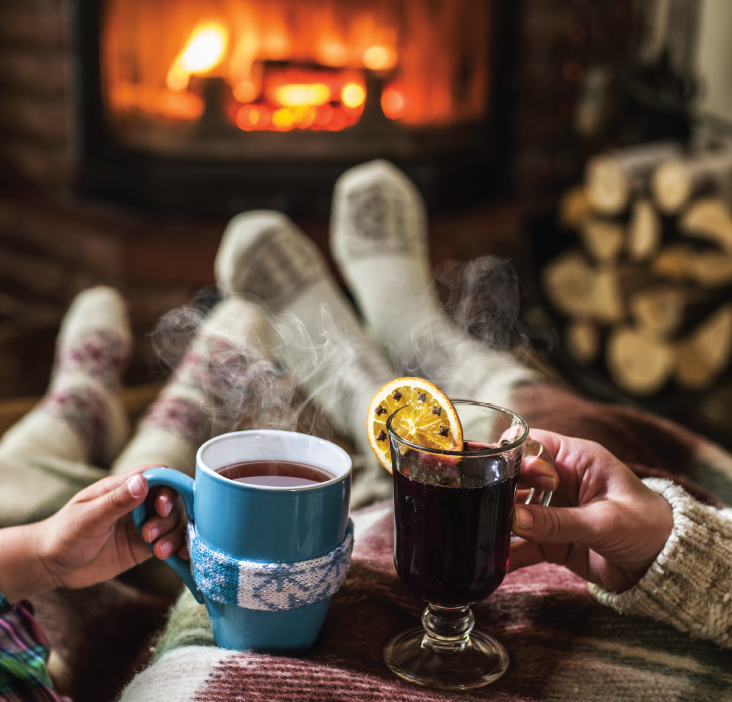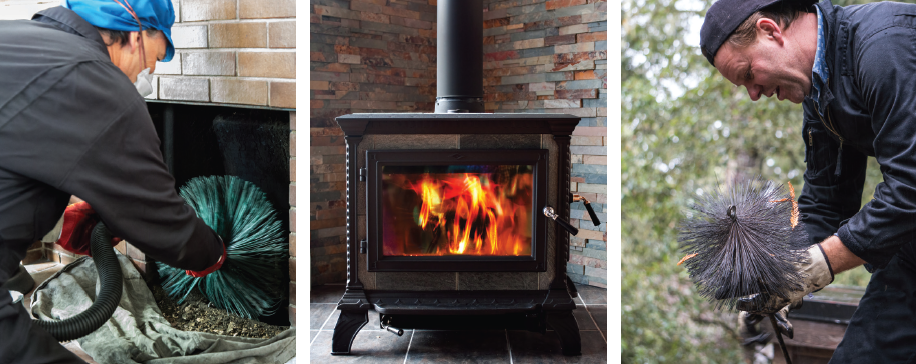Clean Sweep | Is your chimney in tip-top shape?

As the cold weather closes in, most of us are busy with preparations for our winter holidays. We want Santa to have a clean ride down the chimney, and everyone enjoys a crackling fire during the winter season. With the hustle and bustle of the holidays, it is easy to forget about chimney maintenance, so we’ve got the facts and tips you need to know.
Understanding the layout
A chimney is made up of several parts, beginning with the firebox. Some fireboxes include a built-in ash dump, which is an easy way to keep the ashes from accumulating. If you have one, just open the metal door on the firebox floor and sweep the ashes into the ash pit. (The ash pit is emptied periodically through a clean out door in the basement.) If not, then regular scooping and disposal of the ashes is necessary. Next up in the chimney is the damper, a metal vent that keeps rain, birds, bats, and rodents out of your fireplace when you are not enjoying a fire. The damper sits on the smoke shelf, which is below the smoke chamber. Above the smoke chamber is the flue, which draws the smoke from the fire upwards and out of the chimney.
Why and when to clean
Burning wood produces creosote, a flammable tar. Most chimney fires start in the smoke chamber due to a build up of this residue. Burning green logs or pine creates heavy creosote build up. If you see steam or foam bubbling out the ends of the logs when they’re burning, it means the wood is wet. Green wood doesn’t burn cleanly and creates a lot of airborne ash that turns into creosote and soot. Dry hardwoods, such as oak and birch, are better choices for fires. Being dry and dense means they burn hotter and produce less air born particles.
If you see dark, clumpy ash when you open the damper to start a fire, that’s creosote. Even if you don’t see anything, after 50 to 70 fires, it is a good idea to clean your chimney. A way to tell if it’s time is to do an informal inspection yourself. First, clean all the ashes out of the firebox and remove the grate. Wearing eye protection and using a strong flashlight, rub the point of your fireplace poker along the inside of your chimney liner. If you find a thick build up of soot which has a tar-like appearance, this is creosote. Scrape off a section to see how thick it is. If the creosote build up is 1/8 inch or more inside the chimney, it’s time to call a professional chimney sweep.

Getting your chimney inspected
Chimney sweeps are hired for several reasons: They can rid your chimney of heavy creosote, and they are trained to inspect for chimney deterioration. Sweeps recognize poor venting problems and assess your chimney’s structural condition for loose mortar and bricks. John Briscoe of Black Goose Chimney Sweep, Inc. says it well: “If you don’t remember the last time your chimney was swept; if you’ve never had your chimney swept; if you burn 1 ½ cords of wood each year—that is a pile of wood 4′ x 4′ x 8′ —if you have any issues with rodents, water or smoke, or if your chimney is the main way you heat your home, then you need to have your chimney inspected by a professional.”
Briscoe has been a certified chimney sweep since 1990 and gets re-certified every three years. He starts every cleaning with the National Fire Protection Association’s Level 1 inspection. This is the industry standard, and is a visual inspection followed by a chimney cleaning. During the inspection and cleaning, the chimney sweep looks for obstructions, cracks in the chimney liner, and signs of water damage. Older chimneys can have gaps between clay liner sections where the mortar has fallen out. If he sees any damage or structural issues, Briscoe says, “I’ll take a closer look and perform a higher level chimney inspection.”
Finding a chimney sweep
One way to hire a chimney sweep is to get recommendations from friends or family. If they do not have suggestions, an internet search will give you the names and numbers of local sweeps in your area. There are over 1,800 Certified Chimney Sweep® professionals who work across the United States. (Contact the Chimney Safety Institute of America for a list, at csia.org.) You want to find one who is certified, insured and will give you a written estimate before beginning to work on your chimney. Ask how long they have been in business, and for a list of references. It’s also a good idea to check with the Better Business Bureau for any issues. Finally, you’ll want to make certain that their insurance covers them for accidents to the workers as well as to damage that could occur to your home.
Winter is a busy time of year for chimney sweeps, so don’t wait to make your appointment. A warm fire in the fireplace adds cheer to your home, and the heat and colors dancing on the logs make those dark winter evenings cozy. But knowing you are snug and safe is the best feeling of all.
Chimney Cleaning, chimneys, cleaning, Current Issue, fireplace






